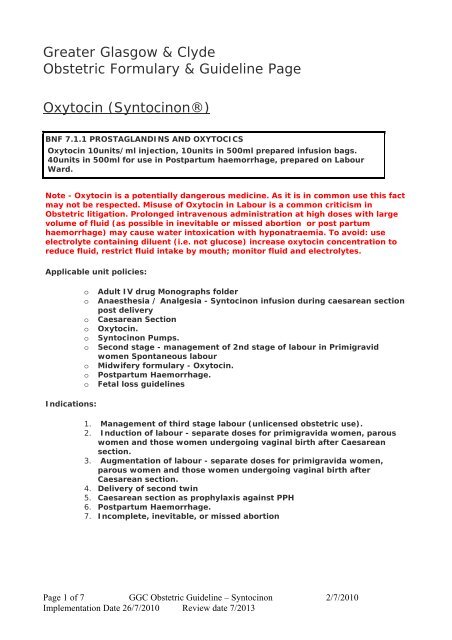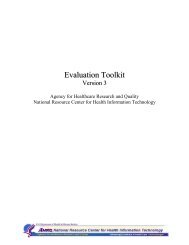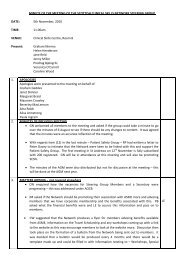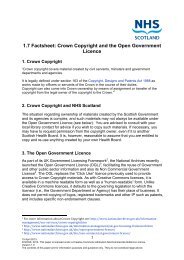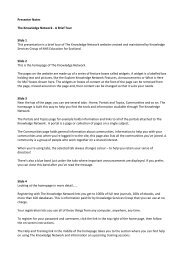Syntocinon guideline GGC.pdf
Syntocinon guideline GGC.pdf
Syntocinon guideline GGC.pdf
Create successful ePaper yourself
Turn your PDF publications into a flip-book with our unique Google optimized e-Paper software.
Greater Glasgow & Clyde<br />
Obstetric Formulary & Guideline Page<br />
Oxytocin (<strong>Syntocinon</strong>®)<br />
BNF 7.1.1 PROSTAGLANDINS AND OXYTOCICS<br />
Oxytocin 10units/ml injection, 10units in 500ml prepared infusion bags.<br />
40units in 500ml for use in Postpartum haemorrhage, prepared on Labour<br />
Ward.<br />
Note - Oxytocin is a potentially dangerous medicine. As it is in common use this fact<br />
may not be respected. Misuse of Oxytocin in Labour is a common criticism in<br />
Obstetric litigation. Prolonged intravenous administration at high doses with large<br />
volume of fluid (as possible in inevitable or missed abortion or post partum<br />
haemorrhage) may cause water intoxication with hyponatraemia. To avoid: use<br />
electrolyte containing diluent (i.e. not glucose) increase oxytocin concentration to<br />
reduce fluid, restrict fluid intake by mouth; monitor fluid and electrolytes.<br />
Applicable unit policies:<br />
o<br />
o<br />
o<br />
o<br />
o<br />
o<br />
o<br />
o<br />
o<br />
Adult IV drug Monographs folder<br />
Anaesthesia / Analgesia - <strong>Syntocinon</strong> infusion during caesarean section<br />
post delivery<br />
Caesarean Section<br />
Oxytocin.<br />
<strong>Syntocinon</strong> Pumps.<br />
Second stage - management of 2nd stage of labour in Primigravid<br />
women Spontaneous labour<br />
Midwifery formulary - Oxytocin.<br />
Postpartum Haemorrhage.<br />
Fetal loss <strong>guideline</strong>s<br />
Indications:<br />
1. Management of third stage labour (unlicensed obstetric use).<br />
2. Induction of labour - separate doses for primigravida women, parous<br />
women and those women undergoing vaginal birth after Caesarean<br />
section.<br />
3. Augmentation of labour - separate doses for primigravida women,<br />
parous women and those women undergoing vaginal birth after<br />
Caesarean section.<br />
4. Delivery of second twin<br />
5. Caesarean section as prophylaxis against PPH<br />
6. Postpartum Haemorrhage.<br />
7. Incomplete, inevitable, or missed abortion<br />
Page 1 of 7 <strong>GGC</strong> Obstetric Guideline – <strong>Syntocinon</strong> 2/7/2010<br />
Implementation Date 26/7/2010 Review date 7/2013
Table 1. Oxytocin infusion 10 units in 500ml<br />
Time after starting<br />
(minutes)<br />
Oxytocin dose<br />
(milliunits per minute)<br />
Volume infused<br />
(ml/hour) of dilution<br />
Oxytocin 10 units in<br />
500ml<br />
0 1 3<br />
30 2 6<br />
60 4 12<br />
90 8 24<br />
120 12 36<br />
150 16 48<br />
180 20 60<br />
210 * 24 72<br />
240 * 28 84<br />
270 * 32 96<br />
Doses highlighted with (*) are quantities above those referred to in the summary of product<br />
characteristics of 20 milliunits per minute.<br />
Indication: 1. Management of third stage labour.<br />
Drug Dose No. of doses Route<br />
Oxytocin<br />
10units/ml inj.<br />
10units<br />
(1ml)<br />
One dose only, give with or after delivery of<br />
the shoulders.<br />
I.M.<br />
Page 2 of 7 <strong>GGC</strong> Obstetric Guideline – <strong>Syntocinon</strong> 2/7/2010<br />
Implementation Date 26/7/2010 Review date 7/2013
Indication: 2. Induction of labour.<br />
Induction of labour should be for a clearly documented reason. Such patients must<br />
have had a spontaneous rupture of membranes or have had a forewater amniotomy<br />
performed prior to commencement of oxytocin.<br />
Primigravida Women - See BNF for restrictions on use.<br />
Drug<br />
Oxytocin<br />
infusion 10<br />
units in 500ml<br />
Compound<br />
Sodium<br />
Lactate<br />
Initial infusion rate set<br />
at<br />
It may be gradually<br />
increased at intervals no<br />
shorter than 30<br />
minutes, until a<br />
contraction pattern<br />
similar to that of normal<br />
labour is established.<br />
Aim for 3 good<br />
contractions in 10<br />
minutes.<br />
Dose Primigravida<br />
Women<br />
No. of<br />
doses<br />
Route<br />
1mU/minute (3ml/hour) Continuous I.V. Inf.<br />
In practice this is<br />
achieved by doubling the<br />
dose at intervals of no<br />
less than 30 minutes to<br />
a maximum of<br />
20mU/minute<br />
(60ml/hour).<br />
Further increase (see<br />
chart above) should be<br />
after discussion with<br />
Middle grade<br />
obstetrician.<br />
Continuous I.V. Inf.<br />
Page 3 of 7 <strong>GGC</strong> Obstetric Guideline – <strong>Syntocinon</strong> 2/7/2010<br />
Implementation Date 26/7/2010 Review date 7/2013
Indication: 2. Induction of labour – continued.<br />
Induction of labour should be for a clearly documented reason. Such patients must<br />
have had a spontaneous rupture of membranes or have had a forewater amniotomy<br />
performed prior to commencement of oxytocin.<br />
Parous women- See BNF for restrictions on use.<br />
These women have a significant risk of uterine rupture, whether or not they have had a<br />
previous caesarean section, and whether or not they are in spontaneous or induced labour.<br />
The maximum dose should be at a rate of 16mU/minute (48ml/hour). Dose increases<br />
above this must be documented in case notes by senior obstetric staff (Middle<br />
Grade rota or above).<br />
OXYTOCIN IS ADMINISTERED TO ACHIEVE 3 GOOD CONTRACTIONS IN 10 MINUTES. THE<br />
DOSE CAN OFTEN BE REDUCED TO MAINTAIN THIS. ONCE IN ESTABLISHED LABOUR A<br />
PAROUS WOMAN IS UNLIKELY TO NEED ESCALATING DOSES OF OXYTOCIN. It is uncommon<br />
for a Parous women in spontaneous labour to require augmentation with oxytocin. Poor<br />
progress in both the first and second stage of labour indicates the need to exclude the<br />
following: malposition, malpresentation, Cephalopelvic, disproportion. Such patients require<br />
assessment by a middle grade obstetrician prior to discussion with a consultant.<br />
Drug<br />
Oxytocin<br />
infusion 10<br />
units in 500ml<br />
Compound<br />
Sodium Lactate<br />
Dose Parous<br />
patients<br />
No. of<br />
doses<br />
Route<br />
Initial infusion rate set at 1mU/minute (3ml/hour) Continuous I.V. Inf.<br />
It may be gradually<br />
increased at intervals no<br />
shorter than 30 minutes,<br />
until a contraction pattern<br />
similar to that of normal<br />
labour is established. Aim<br />
for 3 good contractions in 10<br />
minutes.<br />
In practice this is<br />
achieved by doubling the<br />
dose at intervals of no<br />
less than 30 minutes to a<br />
maximum of<br />
16mU/minute<br />
(48ml/hour).<br />
Continuous<br />
I.V. Inf.<br />
Page 4 of 7 <strong>GGC</strong> Obstetric Guideline – <strong>Syntocinon</strong> 2/7/2010<br />
Implementation Date 26/7/2010 Review date 7/2013
Indication: 3. Augmentation of labour.<br />
This refers to women diagnosed as being established in labour but who have slow<br />
progress which is suspected to be due to inefficient (in-coordinate) uterine<br />
contractions. Membrane rupture must have occurred, whether spontaneous or<br />
artificially. Augmentation is different from induction. Evidence of a positive effect<br />
should be apparent in the next assessment.<br />
Primigravida Women - See BNF for restrictions on use.<br />
Drug<br />
Oxytocin<br />
infusion 10<br />
units in 500ml<br />
Compound<br />
Sodium<br />
Lactate<br />
Dose Primigravida Women<br />
No. of<br />
doses<br />
Route<br />
Initial infusion rate set at 1mU/minute (3ml/hour) Continuous I.V. Inf.<br />
It may be gradually<br />
increased at intervals no<br />
shorter than 30 minutes,<br />
until a contraction pattern<br />
similar to that of normal<br />
labour is established. Aim<br />
for 3 good contractions in<br />
10 minutes.<br />
In practice this is achieved by<br />
doubling the dose at intervals of<br />
no less than 30 minutes to a<br />
maximum of 20mU/minute<br />
(60ml/hour). If commenced for<br />
first time in 2nd stage of labour,<br />
intervals of no less than 20<br />
minutes may be used.<br />
Continuous I.V. Inf.<br />
Parous women- See BNF for restrictions on use.<br />
*Prior to commencing oxytocin for augmentation of labour in parous women an<br />
obstetrician (Middle Grade rota or above) should perform a clinical assessment<br />
including a vaginal examination to exclude any evidence of obstructed labour,<br />
malposition, and /or malpresentation or CPD. A clinical assessment including a<br />
repeat V/E should be performed after 2 hours of oxytocin to ensure effective<br />
progress.<br />
These women have a significant risk of uterine rupture. Particularly high risk groups are<br />
women with previous caesarean section or high parity (para >4), the maximum dose should<br />
be at a rate of 16mU/minute (48ml/hour). Dose increases above this must be<br />
documented in case notes by senior obstetric staff (Middle Grade rota or above).<br />
Drug<br />
Oxytocin<br />
infusion 10<br />
units in 500ml<br />
Compound<br />
Sodium Lactate<br />
Dose Parous patients<br />
Initial infusion rate set at 1mU/minute (3ml/hour)<br />
It may be gradually<br />
increased at intervals no<br />
shorter than 30 minutes,<br />
until a contraction<br />
pattern similar to that of<br />
normal labour is<br />
established. Aim for 3<br />
good contractions in 10<br />
minutes.<br />
In practice this is achieved by<br />
doubling the dose at intervals<br />
of no less than 30 minutes to a<br />
maximum of 16mU/minute<br />
(48ml/hour). Only a<br />
consultant can commence<br />
oxytocin for first time in 2nd<br />
stage of labour.<br />
No. of<br />
doses<br />
Route<br />
Continuous I.V. Inf.<br />
Continuous I.V. Inf.<br />
Page 5 of 7 <strong>GGC</strong> Obstetric Guideline – <strong>Syntocinon</strong> 2/7/2010<br />
Implementation Date 26/7/2010 Review date 7/2013
Indication: 4. Delivery of second twin in those women who do not have an<br />
oxytocin infusion running and after confirming a longitudinal lie and a normal CTG.<br />
Drug<br />
Oxytocin<br />
infusion 10<br />
units in 500ml<br />
Compound<br />
Sodium Lactate<br />
Dose<br />
No. of<br />
doses<br />
Route<br />
Initial infusion rate set at 2mU/minute (6ml/hour) Continuous I.V. Inf.<br />
It may be gradually<br />
increased at intervals no<br />
shorter than 20 minutes,<br />
until a contraction pattern<br />
similar to that of normal<br />
labour is established. Aim<br />
for 3 good contractions in 10<br />
minutes.<br />
In practice this is<br />
achieved by doubling the<br />
dose at intervals of no<br />
less than 20 minutes to a<br />
maximum of<br />
16mU/minute<br />
(48ml/hour).<br />
Continuous<br />
I.V. Inf.<br />
Indication: 5. Post Caesarean Section prophylaxis<br />
Elective and emergency Caesarean Section are associated with increase risk of PPH. Uterine<br />
atony after long labour. Multiple pregnancy and high parity are particular risks<br />
Drug<br />
Dose<br />
No. of<br />
doses<br />
Route<br />
Oxytocin injection<br />
5 units after delivery of the baby<br />
then see below<br />
once only<br />
IV BOLUS<br />
slowly<br />
Oxytocin infusion equivalent to<br />
15 units in a fresh bag of 500ml<br />
Compound Sodium Lactate.<br />
Aim for infusion to be completed<br />
by 30 minutes.<br />
Continuous<br />
I.V. Inf.<br />
Notes<br />
*Oxytocin Maximum dose should rarely exceed 50 units total.<br />
Page 6 of 7 <strong>GGC</strong> Obstetric Guideline – <strong>Syntocinon</strong> 2/7/2010<br />
Implementation Date 26/7/2010 Review date 7/2013
Indication: 6. Postpartum Haemorrhage.<br />
Drug<br />
Oxytocin infusion 40 units in 500ml<br />
Compound Sodium Lactate.*<br />
Dose<br />
No. of<br />
doses<br />
Route<br />
125ml/ hour. Continuous I.V. Inf.<br />
* In fluid restricted patients Oxytocin 40 units in 40ml Sodium Chloride 0.9% infused IV<br />
at 10ml /hr may be considered.<br />
Indication: 7. Incomplete, inevitable or missed abortion – when prostaglandins<br />
have not been successful or are contraindicated.<br />
Drug<br />
Oxytocin injection<br />
Oxytocin infusion 10 units in<br />
500ml Compound Sodium<br />
Lactate.<br />
Dose<br />
5 units then see below if<br />
necessary<br />
Initially 20 to 40<br />
milliunits/minute (60ml/hr to<br />
120ml/hr) or higher<br />
No. of<br />
doses<br />
Once only<br />
Route<br />
IV BOLUS<br />
slowly<br />
Continuous I.V. Inf.<br />
Authors<br />
Updated by Dr A M Mathers, Dr F Mackenzie, J Grant, Pharmacist, Check A M Smith,<br />
Pharmacist, on behalf of GONEC Group<br />
Title<br />
Oxytocin Guideline_Obstetrics Version 1<br />
Implementation / review Dates<br />
Implementation 26/7/10 Review date 7/13<br />
Approval<br />
A.M. Mathers, Clinical Director..................................... Date .......................<br />
Page 7 of 7 <strong>GGC</strong> Obstetric Guideline – <strong>Syntocinon</strong> 2/7/2010<br />
Implementation Date 26/7/2010 Review date 7/2013


